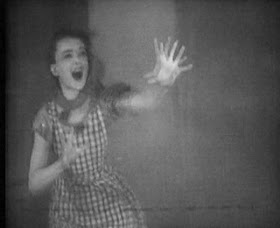 |
| Frame grab from The Wind (Victor Sjöström, 1928). Read Bo Florin's article on this film |
[Traditionally, aesthetics] has been based on national perspectives and contexts, as well as contained within the limits of specific disciplines. However, the changing society has made this focus all too narrow. Due to globalization, media and territories merge and move in new ways, where regional, national, international, and global perspectives increasingly integrate. New contexts and new aesthetic strategies are also created, and traditional boundaries and hierarchies become transgressed, for example, between high brow and popular culture, or between art and technology. Aesthetics as well as culture thus need to be discussed and interpreted across the disciplines, through different media, over territorial borders. Finally, this is also a strong argument for Open Access publishing: to constitute a global platform and an interface for interdisciplinary discourse—free for anybody to read. [from first JAC Editorial by Astrid Söderbergh Widding, Lars Gustaf Andersson and John Sundholm]Film Studies For Free had been meaning to post something about the Journal of Aesthetics and Culture for quite a while. It's an online open access journal, hence one very much after this blog's's heart, with a high percentage of very good quality film-studies related articles that FSFF has frequently linked to on Twitter.
Today, JAC published an excellent dossier on Transnational Cultural Memory, an event which provided a wonderful prompt to gather together, in one place, links to everything that JAC has published to date. And below, that is just what you will find.
FSFF has also added JAC to its permanent listing of excellent, Open Access film and moving image studies journals.
Vol. 1 (2009)
- Editorial by Astrid Söderbergh Widding, Lars Gustaf Andersson, John Sundholm (PDF HTML XML)
- Sean Cubitt, Thinking filming thinking filming (PDF HTML XML)
- Thomas Elsaesser, Ingmar Bergman in the museum? Thresholds, limits, conditions of possibility (PDF HTML XML)
- Julia Creet, Calling on Witnesses: testimony and the deictic (PDF HTML XML)
- Bodil Marie Stavning Thomsen, Antichrist – Chaos Reigns: the event of violence and the haptic image in Lars von Trier’s film (PDF HTML XML)
- Anu Koivunen, Confessions of a Free Woman: telling feminist stories in postfeminist media culture (PDF HTML XML)
- Tiina Rosenberg, On feminist activist aesthetics (PDF HTML XML)
- Bo Florin, Confronting The Wind: a reading of a Hollywood film by Victor Sjöström (PDF HTML XML)
- Editorial by Astrid Söderbergh Widding, Lars Gustaf Andersson, John Sundholm (PDF HTML XML)
- Irina Aristarkhova, Hosting the animal: the art of Kathy High (PDF HTML XML)
- Maaret Koskinen, Ingmar Bergman, the biographical legend and the intermedialities of memory (PDF HTML XML)
- Timotheus Vermeulen, Robin van den Akker, Notes on metamodernism (PDF HTML XML)
- Anita Seppä, Globalisation and the arts: the rise of new democracy, or just another pretty suit for the old emperor? (PDF(high) PDF HTML XML)
- Tytti Soila, Passion at the threshold: Doctor Glas the flaneur in the films of Rune Carlstén and Mai Zetterling (PDF HTML XML)
- Ryszard W. Kluszczynski, Strategies of interactive art (PDF(high) PDF HTML XML)
- Michael Laurence Woods, What it is? A question on the derivation of musical meaning (PDF HTML XML)
- Matthew Mullane, The aesthetic ear: sound art, Jacques Rancière and the politics of listening (PDF HTML XML)
- Sven-Olov Wallenstein, Space, time, and the arts: rewriting the Laocoon (PDF HTML XML)
- Torkild Thanem, Louise Wallenberg, Buggering Freud and Deleuze: towards a queer theory of masochism (PDF HTML XML)
Vol 3 (2011)
- Lisbeth Söderqvist, Structuralism in architecture: a definition (PDF HTML EPUB XML)
- Per-Arne Bodin, The holy fool as a TV hero: about Pavel Lungin’s film The Island and the problem of authenticity (PDF HTML EPUB XML)
- Des O'Rawe, Towards a poetics of the cinematographic frame (PDF HTML EPUB XML)
- Erik van Ooijen, Cinematic shots and cuts: on the ethics and semiotics of real violence in film fiction (PDF HTML EBUB XML)
- Dossier on Transnational Cultural memory
- John Sundholm, Adrian Velicu, Introduction to the dossier on transnational cultural memory (PDF HTML EPUB XML)
- Astrid Erll, Traumatic pasts, literary afterlives, and transcultural memory: new directions of literary and media memory studies (PDF HTML EPUB XML)
- Steffi Hobuß, Aspects of memory acts: transnational cultural memory and ethics (PDF HTML EPUB XML)
- Adrian Velicu, Cultural memory between the national and the transnational (PDF HTML EPUB XML)
- John Sundholm, Visions of transnational memory (PDF HTML EPUB XML)
- Julia Creet, Transnational archives: the Canadian case (PDF HTML EPUB XML)
- Anna-Kaisa Kuusisto-Arponen, Transnational sense of place: cinematic scenes of Finnish war child memories (PDF HTML EPUB XML)




